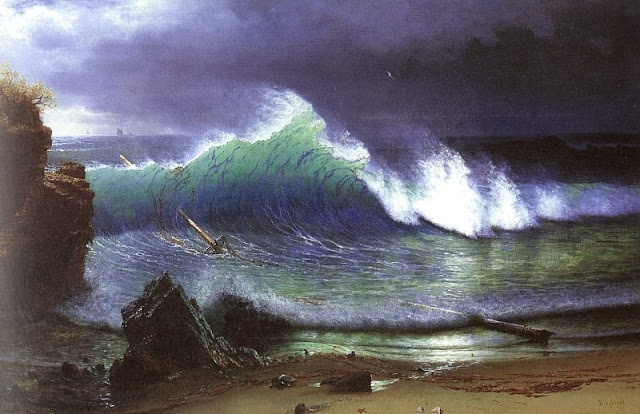Waves in 19th Century Art: the Emerald Wave of Albert Bierstadt
“We need the tonic of wildness...At the same time that we are earnest to explore and learn all things, we require that all things be mysterious and unexplorable, that land and sea be indefinitely wild, unsurveyed and unfathomed by us because unfathomable. We can never have enough of nature.”
― Henry David Thoreau, Walden: Or, Life in the Woods
Albert Bierstadt’s beautiful landscapes have become a symbol of the American West. They’re also somewhat controversial. Idealized and stunning, today they are often seen as part of the Manifest Destiny propaganda. But is this truly all there is to this German-born immigrant’s masterpieces?
Capturing the Dream of the American Frontier in Paint
“The Oregon Trail”. 1869. Albert Bierstadt, The Boca Raton Museum of Art, Florida
Albert Bierstadt (1830-1902) was born in the Rhine Province, Germany, and in his heyday became one of the most famous American painters. His large-scale paintings depict the stunning beauty of American nature – some of the best-known examples include “The Oregon Trail” and “The Valley of the Yosemite”. His family had to move to a new country to secure a future for themselves. While Bierstadt was only a baby during the move, he would have heard first-hand accounts of the hopes and dreams that his family centered on their new place of residence. Both he and his brothers benefited from the move and had successful careers. His older brothers became photographers, and Albert Bierstadt was a best-selling painter for decades.
Albert Bierstadt studied art in Germany, and upon his return he joined the group of landscape painters, who formed the Hudson River School. These artists were influenced by Romanticism, and their works often focused on striking compositions and carefully studied lighting.
“The Valley of the Yosemite”. 1864. Albert Bierstadt, the Museum of Fine Arts, Boston
In 1859, Bierstadt travelled West for the first time. The 30-year-old artist was genuinely impressed and inspired by the magnificence of what he saw. His painting, “The Valley of the Yosemite” set the record for the highest price for an American painting in 1865. Not everyone liked Bierstadt’s dramatic paintings, though. Many critics found them too artificial and staged. Mark Twain thought his views of the Yosemite Valley “very beautiful, considerably more beautiful than the original[1].”
Luminism: In Search of the Light
“Kern's River Valley, California”. 1871. Albert Bierstadt
His use of light to bring out the majestic and ideal in the landscape was typical for American Luminism. It was a style that, like Impressionism, aimed to capture fleeting light effects. It did so, however, in a very different way. Luminists didn’t paint in the loose brushstrokes of the Impressionists. The surface was polished and smooth so that the individual brushstrokes didn’t show.
The Luminists were closely associated with Transcendentalism, a philosophical movement evidenced in the writings of American thinkers like Ralph Waldo Emerson and Henry David Thoreau. The Luminists aimed to show the presence of God in the landscapes they painted by infusing their images with light.
On the Shores of the Turquoise Sea
Not all of Bierstadt’s paintings depict the West. Many would even argue that his best paintings don’t.
“The Shore of the Turquoise Sea”. 1878. Albert Bierstadt, Manoogian Collection, Detroit
Bierstadt painted “The Shore of the Turquoise Sea” in 1878. He and his wife, Rosalie, were living in Nassau, because of his wife’s failing health. She was diagnosed with consumption, and the pair moved to the warmer climate of the Bahamas in an attempt to alleviate her symptoms.
In “The Shore of the Turquoise Sea”, Bierstadt paints an ethereal seascape, where only a few cliffs and a stretch of sand establish the shore – the rest of the canvas is taken up by the sea and sky. The clouds over the sea are dark, and it’s unclear whether a storm has just passed or whether one is coming. Like in another masterpiece depicting a wave, Hokusai’s “The Great Wave Off Kanagawa”, the focus of the painting is the frothy wave in the center of the canvas. Bierstadt showed off his skill in capturing how the sunrays make the water glow in blue, green, and golden hues. The stark white of the foam contrasts vividly with the blue-black waves in the right corner.
Themes in “The Shore of the Turquoise Sea”
“The Shore of the Turquoise Sea”. detail. 1878. Albert Bierstadt
Painted at a time when the artist’s wife was ill, the image of the heaving wave rising over the remains of a shipwreck suggests a feeling of human helplessness before fate. The sea is presented as beautiful, powerful, but merciless. However, the painting doesn’t focus on the dark, instead highlighting the sun’s rays on the water and the precise moment in time that the wave is at its highest, seafoam blown by the wind from its crest.
It’s a painting that allows both a hopeful and a sad interpretation; if the storm has finished, then the ship in the distance has made it to shore safely. If the beginning of a storm is portrayed, then perhaps the broken mast in the foreground hints at the perils awaiting the far-off vessel. Either way, the sea is there, powerful, beautiful, and mysterious.
Further Reading:
Luminism Movement Overview, https://www.theartstory.org/movement/luminism/
Museum of Fine Arts Boston, https://collections.mfa.org/objects/33107
Romanticism: Wolf, Norbert. Taschen, 2007
The Shore of the Turquoise Sea, https://www.thehistoryofart.org/albert-bierstadt/shore-of-the-turquoise-sea/
[1] Discovery and Invention in the Yosemite, https://xroads.virginia.edu/~MA96/RAILROAD/yosemite.html








Comments
Post a Comment